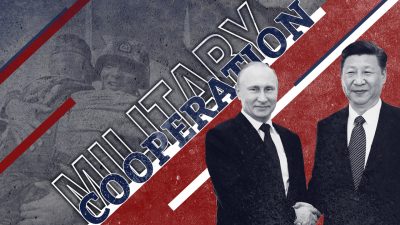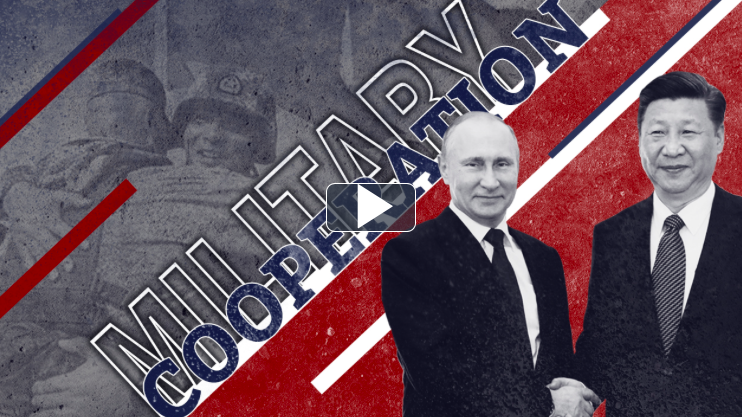New ‘Red’ Bloc: Russia -China Alliance

On October 1, China celebrated the 70th Anniversary of the Founding of the People’s Republic of China. This analysis is designed to provide a broader perspective to the Chinese-Russian military cooperation at the moment.
***
For starters, one should note that the Russian Federation and the People’s Republic of China are not in any formal military alliance providing for a form of common defense such as NATO for example. They are, however, in a longstanding collective security arrangement exemplified by the Shanghai Cooperation Organization (SCO) as well as a number of bilateral treaties and agreements governing mutual relations. This includes the delineation of a mutual border to eliminate territorial disputes. Such disputes have, in the past, been a perennial source of conflict between Russia and China, occasionally erupting into outright warfare, most recently in the form of the Amur River border clashes of the late 1960s.
As far as collective defense is concerned, the two countries have a shared interest in the form of preventing further encroachment upon their security and economic interests in their respective border buffer areas. For Russia, that area is Eastern Europe, the Caucasus, Central Asia, and friendly states of the Middle East such as Syria. For China, it’s the South China Sea, Myanmar, Hong-Kong, and, to a certain extent, Central Asia as well. While the geography of conflict is almost entirely non-overlapping for the two countries, the identity of security concern sources is virtually identical—it’s the United States and, more broadly, NATO, along with a loose array of regional allies interested in establishing a lasting Anglo-Saxon hegemony on a planetary scale. Russia and China, on the other hand, for rather obvious and understandable reasons, are disinterested in being part of a world order built on the Washington-centric principle.
The histories of the two countries are replete with examples of aggression by Western powers believing themselves to be the bearers of some historic mission. The current edition of “American Exceptionalism” does not differ essentially from earlier episodes, not in ultimate aim or in the combination of military and non-military approaches towards imposing one’s will on non-Western political actors. Instead, Russia and China are in agreement that the ideal world order would be multipolar, rather than unipolar or even a bipolar one. It is with that aim, which actually closely resembles the vision of world order reflected in the institutional design of the UN Security Council—a multipolar world populated by 5 major powers which maintain order in their own respective spheres of influence and do not seek self-aggrandizement at the expense of other major powers.
Such military cooperation as exists between Russia and China is intended to further that objective. It is not more extensive than its current form for two reasons. Reason one is that both Moscow and Beijing still hold out the possibility of Washington coming to its senses after it realizes the limits of its power and acknowledges that it cannot dictate its will to other major powers.
For historic and cultural reasons, this belief is rather stronger in Moscow than Beijing. Reason two is that neither Moscow nor Beijing wishes to become the other’s satellite or even overly dependent upon the other. Russia needs markets for its defense products to underwrite the development of future technologies and to lower the cost of weapon system procurement. It does not need China to become entirely self-sufficient in that realm or to start competing with Russia in other markets. China wants advanced weapon systems to parry the build-up of advanced weapons all along its periphery. It does not want to be overly dependent upon Russia which could, after all, undergo a political reorientation toward the West and away from China. One of the aims of the regime change push against Russia of the past decade was precisely that: once Russia becomes a US satellite, China’s position becomes far less tenable.
This has largely been a one way street—Russia sells to China, but does not buy from China—for the past several decades. There is also a discernible pattern—China acquires a Russian weapon system, copies it, and then puts it into production and service. This approach has not always worked. If it did, China would not be continually procuring advanced Russian combat aircraft for example. China is, however, self-sufficient in small arms, armored vehicles, artillery, missiles and rocketry, and most naval needs, with many of even today’s advanced Chinese systems (e.g. main battle tanks) still bearing recognizable signs of their Soviet origin.
Whether these Chinese weapons are as capable as Russian or Western equivalents is another question. China’s leadership clearly believes they are good enough and, moreover, has to contend with its own “military industrial complex” and its desire to master the mass production of weapons. China’s priorities do include the development of an indigenous technological base through a combination of internal investments and acquisition of technologies from abroad. The foreign sources of technologies include the West, but also Russia (through industrial espionage) and even former Soviet republics where components of the Soviet military-industrial complex still reside. China’s efforts to acquire Ukraine’s Motor Sich and its legacy Soviet technologies is a case in point.
However, there are reasons to believe China’s indigenous weapons still lag behind those of Russia. This is particularly pronounced in the aerospace realm, where the Su-35 remains the most advanced air combat fighter in the PLAAF’s inventory, in spite of the existence of numerous PRC-designed fighter aircraft. China’s industry has struggled with the design of jet engines suitable for gen. 4++/5 fighters of which capabilities such as “super-cruise” are demanded. It is also debatable whether China’s industry can replicate the performance of Russia’s phased array radars or electronic warfare systems. That the Su-35 represents superior capability to Chinese designs was evident in the Russia-China negotiations concerning the purchase of such systems. China was initially interested in procuring only a small batch of the fighters, suggesting an interest in not so much re-equipping the PLAAF but in “cloning” the aircraft or its components. Ultimately Russia prevailed upon China to purchase a substantial quantity of the aircraft.
The situation in other realms is likely not different. In head-to-head Tank Biathlon contests under controlled conditions and with highly trained crews, China’s Type 96B did not display superiority over Russia’s T-72B3, even though it’s of a newer design. It is also interesting that while Russia’s naval shipbuilding is struggling to meet the Russian Navy’s demand for new construction and refurbishment of existing ships China’s naval industry, by contrast, is churning out major surface combatants by the dozen. Russia has not placed orders for any ships in Chinese shipyards.
Finally, there is a striking absence of joint weapon system development even though the security needs of the two countries overlap. Instead, we see parallel development of weapons with similar capabilities in both countries. This is likely due to Russia’s fear of compromising its superior technological know-how in joint development efforts with China.
While Russia and the PRC have held joint exercises on land, air, and sea, and the Chinese military is a regular participant in Russia’s annual Army Games, to the point of bringing its own equipment, these exercises still have a mostly political rather than military character. They are intended to demonstrate Moscow and Beijing’s solidarity on a broad range of political issues rather than to develop procedures for joint military action. It appears that both Moscow and Beijing seek to preserve their own freedom of action. Thus military engagement between the US and China in the Pacific would not automatically provoke a Russian response, and, likewise, a US-Russia clash in the Black Sea or Mediterranean would not necessarily draw in China’s military. Instead, the joint exercises are intended to impress upon third parties the possibility of a joint Russian-Chinese military action at some point in the future where urgent national interests dictate it. They certainly are laying the groundwork for a future expansion of military cooperation through the establishment of stable and persistent military-to-military contacts, but the leap into a military alliance has yet to be made.
The Russia-China relationship is symptomatic of a future multipolar world order where alliances between major powers will be shallow and situational. Indeed, a deep alliance integration is only possible where one member of the alliance clearly dominates all other members, as in the case of NATO, or where the allies are so deeply integrated in the political and economic sense that military integration is a logical next step. The discussions concerning a “European Army” are an example of that latter pattern of military cooperation. Since Russia and China are very likely to dominate one another, or to become economically very highly interdependent, the current level of cooperation will continue unless a dire military threat emerges in the future. Current US military modernization policies are clearly intended to pose that level of threat to both countries to which they would almost certainly attempt to deflect through advancing their cooperation to the next level. At the same time, both Moscow and Beijing still believe Washington has not irreversibly crossed the Rubicon of great power conflict.
*
Note to readers: please click the share buttons above or below. Forward this article to your email lists. Crosspost on your blog site, internet forums. etc.
Support South Front in its endeavors.
If you’re able, and if you like our content and approach, please support the project. Our work wouldn’t be possible without your help: PayPal: [email protected] or via: http://southfront.org/donate/ or via: https://www.patreon.com/southfront


